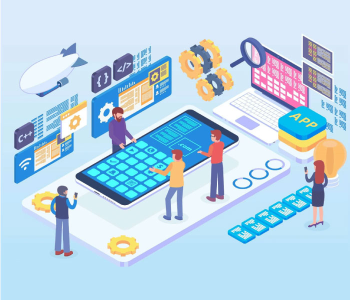A Comprehensive Guide to Mobile App Development
In our rapidly evolving digital era, the significance of mobile applications cannot be overstated. Mobile app development has become a cornerstone for businesses aiming to stay competitive and provide seamless user experiences. In this blog post, we'll explore the dynamic landscape of mobile app development, covering essential aspects from inception to deployment.
Understanding the Mobile App Development Process:
1. Define Your Objectives:
Before delving into coding and design, it's crucial to define the purpose and goals of your mobile app. Understanding your target audience, desired features, and the problem your app aims to solve lays the foundation for a successful development journey.
2. Choose the Right Platform:
Deciding whether to develop for iOS, Android, or both is a critical decision. Factors such as target audience demographics, market share, and your budget will influence this choice. Each platform has its unique requirements and design principles, necessitating careful consideration.
3. Wireframing and Design:
Creating wireframes and mockups is an essential step in the design phase. This visual representation helps in refining the app's user interface (UI) and user experience (UX). Collaborating with designers to create an intuitive and visually appealing design is key to user engagement.
Development Essentials for Mobile Apps:
1. Choose the Right Development Tools:
Selecting the appropriate development tools and frameworks is crucial. For native app development, tools like Xcode (for iOS) and Android Studio (for Android) are commonly used. Cross-platform development can be achieved with frameworks like React Native or Flutter.
2. Focus on User Experience (UX):
A seamless user experience is paramount for the success of any mobile app. Pay attention to intuitive navigation, responsive design, and minimizing loading times. User feedback and usability testing play vital roles in refining the app's UX.
3. Security Considerations:
Mobile app security is a non-negotiable aspect. Implement secure coding practices, use encryption for sensitive data, and regularly update the app to patch any vulnerabilities. Prioritize user privacy to build trust in your app.
Testing and Quality Assurance:
1. Rigorous Testing Protocols:
Thorough testing is essential to identify and rectify bugs and glitches. Conduct functional, usability, performance, and security testing throughout the development lifecycle. Emulators and real device testing help ensure compatibility across various devices.
2. User Feedback Integration:
Encourage beta testing and gather user feedback to identify areas for improvement. This iterative process ensures that the app meets user expectations and addresses any issues before the official launch.
Deployment and Post-Launch Strategies:
1. App Store Optimization (ASO):
For apps targeting iOS and Android, optimizing your app's presence on the respective app stores is vital. This includes crafting compelling app descriptions, using relevant keywords, and creating eye-catching visuals.
2. Marketing and Promotion:
Develop a comprehensive marketing strategy to promote your app. Utilize social media, content marketing, and paid advertising to increase visibility. Engage with your target audience and encourage user reviews to build credibility.
3. Continuous Improvement:
Post-launch, monitor app performance, gather user feedback, and implement updates regularly. Stay abreast of technological advancements and user trends to ensure your app remains competitive and delivers value over time.
Embarking on a mobile app development journey is an exciting endeavor, filled with challenges and opportunities. By understanding the intricacies of the process, staying attuned to user needs, and prioritizing quality, businesses can not only create successful mobile applications but also carve a niche in the ever-expanding realm of mobile technology.










